
Audience
- Sentiment: mixed
- Political Group: unlikely to align with a specific group
- Age Group: 25-45
- Gender: both genders likely
Overview
- The Dodgers have committed over $450 million in a recent offseason to enhance their roster, including a record-setting $700 million contract for Shohei Ohtani.
- The financial gap between large and small market teams in MLB is widening, raising concerns about competitive balance in the league.
- MLB Commissioner Rob Manfred highlighted both the Dodgers’ commitment to winning and the broader financial issues affecting smaller market teams.
The Dodgers’ Big Bets: What Their $450 Million Offseason Means for MLB
In the world of Major League Baseball (MLB), the Los Angeles Dodgers are making headlines like never before. After celebrating their World Series victory in 2024, the Dodgers decided they weren’t done. Instead of resting on their laurels, they opted for a jaw-dropping offseason strategy, spending over $450 million to boost their already impressive roster. But this isn’t just any regular spending spree; it’s happening alongside a record-setting $700 million contract with superstar Shohei Ohtani. With all this financial muscle, the Dodgers have committed over $2 billion to just seven players and are planning to defer a chunk of that money until the year 2046.
Now, if you’re both a fan of baseball or just curious about the game’s business side, you might be asking yourself, “What does all this mean?” or “Why are fans of smaller market teams upset?” Let’s break it down to understand the implications of this extravagant spending and what it could mean for the future of MLB.
The Dodgers and Their Financial Power
Firstly, let’s talk about the financial magnitude of what the Dodgers are doing. Committing $2 billion to just a handful of players is a staggering number. For comparison, some smaller market teams might spend that much on an entire roster for a few seasons! The Dodgers’ commitment showcases not just their ambition but also how rich and powerful a franchise can be in Major League Baseball.
It’s fascinating but also concerning. Baseball fans might cheer for their favorite team without realizing the vast differences in financial power between the teams. Teams based in huge cities like Los Angeles or New York often make more money from ticket sales, merchandise, and local TV deals than teams located in smaller cities. This creates a huge gap, affecting the competitive balance of the league.
The Dodgers, often seen as a symbol of success in MLB, have harnessed this financial power to attract top talent, making their roster one of the most formidable in the game. But many fans believe that this isn’t fair. Are the Dodgers buying championships? Or are they simply using what they have to keep winning? There is a fine line, and that’s the heart of the debate.
Deferring Payments: An Inside Look
One of the intriguing aspects of the Dodgers’ strategy is their choice to defer a large portion of player payments until 2046. At first glance, this might sound like a smart financial move. By delaying payment, the Dodgers can allocate their funds towards other areas such as scouting, player development, or even bolstering their farm system (the leagues of younger players). This gives them flexibility in budgeting right now while maintaining their star-studded lineup.
However, there are consequences to this strategy. If the Dodgers win multiple championships in the current era but have to pay for it decades later, how will that affect their long-term financial viability? Some critics might argue that this sets a dangerous precedent. Why should a team defer payments? Shouldn’t teams be responsible for the contracts they offer immediately? These are questions that fans and analysts alike are pondering.
Moreover, the impact of this deferral system can extend beyond just the Dodgers. For smaller market teams, these choices can further widen the financial gap. If the Dodgers succeed with their strategy, other teams might feel pressured to spend excessively to keep up, knowing that they’re already at a disadvantage. The cycle continues, and that’s where the issue of competitive balance becomes crucial.
Commissioner Manfred’s Take
MLB Commissioner Rob Manfred has weighed in on this situation. In his statements, he defended the Dodgers’ approach, highlighting their commitment to winning and their competitive spirit. However, he also acknowledged the concerns that fans of smaller market teams have regarding the overall balance of competition in the league.
In a way, Manfred’s perspective is both reassuring and unsettling. It’s great to hear that the league values competitiveness; however, it illuminates a more significant issue within MLB: the flaw in its financial system. Manfred pointed out that the problem doesn’t just lie with the Dodgers. It’s the entire financial structure of MLB that might need re-evaluating. As larger teams continue to dominate financially, can smaller teams ever truly compete?
The Competitive Landscape of MLB
The $450 million offseason and the staggering record contracts will be a hot topic for the next few seasons. These moves raise many questions about the future of MLB. For instance, how can a team like the Oakland Athletics or the Cincinnati Reds compete when they can barely afford to sign one star player?
In smaller markets, teams have to be scrappy. They often rely on developing talent through their farm systems (the minor leagues) or making savvy trades to build a competitive team without breaking the bank. However, with franchises like the Dodgers flexing their financial muscles, it makes it increasingly challenging for these smaller teams. Talent can become concentrated in just a few teams, leading to one-sided matchups that can be less exciting and more predictable for fans.
The Broader Implications
The conversation of spending in MLB isn’t just about baseball; it crosses over into broader societal themes too. It reflects topics such as income inequality in sports, how wealth can dictate success, and whether success in sports should be more closely tied to teamwork and strategy rather than who has the most dollars to spend.
We love rooting for underdog teams, don’t we? There’s something exciting about a scrappy team from a small market making a playoff appearance and giving the big boys a run for their money. Yet, if the current spending trends continue, fans may witness increasingly fewer championship opportunities for these teams.
Conclusion: What Does This All Mean for Fans?
So, as a baseball fan or a casual observer, what does all this mean for you? For one, it creates an engaging narrative. Watching the rich get richer is always a story that intrigues many. Will the Dodgers live up to their massive investments? Can smaller teams find the formula for success despite these financial giants?
All of these developments create an exciting yet complex landscape in which fans can see how money influences the sport they love. It also invites us to think critically about fairness and competition in sports.
What are your thoughts? Are you excited to see what the Dodgers will do with their talent? Or do you worry that MLB is starting to lose its competitive balance? Share your thoughts in the comments; I’d love to hear what you think!




